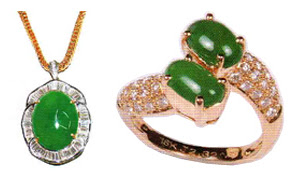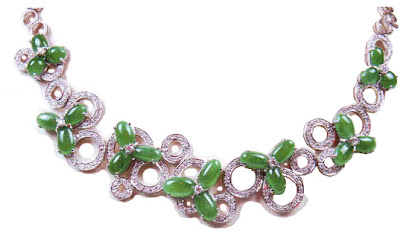 Jade has been known to man since prehistoric time. However, way back then it was used to make weapons rather than jewels. It was the Chinese emperors who reigned around 3000 BC that first recognized the stone's beauty and declared it a 'Royal Gem'. So significant was the jewel to them, they forbid anyone who was not a member of the royal family to wear it. They also carved their seals out of the stone.
Jade has been known to man since prehistoric time. However, way back then it was used to make weapons rather than jewels. It was the Chinese emperors who reigned around 3000 BC that first recognized the stone's beauty and declared it a 'Royal Gem'. So significant was the jewel to them, they forbid anyone who was not a member of the royal family to wear it. They also carved their seals out of the stone.It was not only in Asia that jade was considered a royal jewel. The Mayan, Aztec and Olmec monarchs of ancient Central America also took this rare and beautiful gem as their own. The tomb of Mayan king found at Copan in Honduras contained the remains of a member of royalty with tiny cabochon jade embedded in twl of his front teeth. A female skeleton, also found in the tomb, had more than 10,000 jade beads scattered around her legs. She also wore a carved jade pendant around her neck, which was lightly covered in Cinnabar ( a red organic paint ) so that the green color of the gem stood out in places.

Not only has jade been associated with royalty, in ancient times it was also believed to posses certain mystical powers. Today, some still believe the gem will bring love, inner peace, harmony and balance to those who treasure it.
It is a little known fact that the name jade actually refers to two different types of stone nephrite and jadeite. Both are hard stones but the difference is in their color. Nephrite is mainly mid to dark green or grey-green. It can also be white, yellowish or reddish. Jadeite is slightly harder than nephrite and is a brighter, more translucent green. It can also be white, pink red, black, brown, violet, although, green jadeite is the most prized. Violet colored jade, however, is becoming increasingly fashionable and is fetching increasingly higher prices. The vest quality jade, whether it is nephrite or jadeite, has a uniform color.
Nephrite is mainly used for carved objects such as figurines. The stone is naturally found in China, New Zealand, Russia, Guatemala, the Swiss Alps and Western Canada.
China, Russia and Guatemala also produce the more prized jadeite. However, international gemologists unanimously agree that the best jadeite comes from Myanmar.

Hpakant in mountainous Kachin State, in the far northern part of Myanmar has long been home to the most famous jade mine in the world. Its reputation is comparable to the ruby mines found in Mogkok, also in Myanmar. There are other smaller jade mines scattered across the tip of the country, but it is Hpakant that is internationally recognized, For centuries this mine has been Producing the most sought after color of jade; the rare emerald green that is considered Imperial Jade, fit only for emperors.
For centuries it has been giving up its treasures but none could rival what was unearthed there on New Year's Day 2001 the largest jade boulder ever found in the world.
On that chilly January day a mechanical prove was sent 40 feet into the ground. It touched upon the boulder, which proved to be jade.

When the earth around the boulder was cleared away, it measured 70 ft in length, 36 ft in height and 15 ft in width, It had slept like a giant dragon under the ground. Perhaps it is just a coincidence, but 2001 was
-according to Chinese mythology
-the year of the double dragon.
News spread like wildfire among the other miners in the region and it was celebrated exuberanyly for the rest of the day.
The best jade is always found deep inside other stones, enclosed in a shel-like casing. The awesome boulder found at Hpakant also has a protective shell that was breached to check the color. It as found to have an almost pure white exterior with patches of green and violet breaking through. Gemologists found the green, in particular, to be of a brilliant hue.
So far it has not been raised to the surface. It remains in the earth; a hidden National Treasure. While it sleeps undisturbed the Hpakant mines continue to give up jade boulders of excellent quality, though none anywhere near that size. The ones found since have been somewhere between size of a small car and an oil drum.
The day when the giant is raised will be one of the glories for the people of Myanmar, for they will finally be able to present its grandeur to the world.
 THE LOCATION OF HPAKANT
THE LOCATION OF HPAKANT

